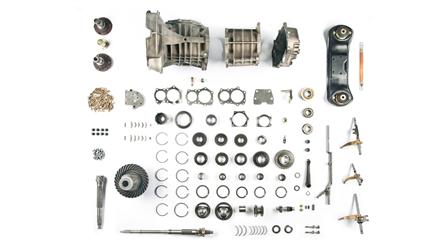The transmission engages: the 911 T gets back into gear
The willing and responsive power of 140 hp can really test metal to the limit. This power does not necessarily make it grind its teeth under the strain, but sharp points become blunt bumps, and this can have a negative impact on forward drive. The transmission has been working for 37 years now and keeping the 911 in gear. As a result, a few clear signs of wear and tear are not the end of the world. Rather, they are something to be remedied with patience and great attention to detail.
The team in the Porsche Classic workshop already started working deep inside the vehicle. Until the middle of next year they still have time to fulfil the motto of the “Revive the Passion” campaign. By then, this object of desire must appear in a new and shiny, technically perfect state. The 911 T was originally built in 1973 and was found and chosen for restoration in its home town of Stuttgart by the Porsche Club of America (PCA) in a joint project with Porsche Classic and the Porsche Club Coordination in Los Angeles. After restoration is completed, it will be handed over next year for its intended purpose: it will be raffled off among PCA members and presented to the public at the Porsche Parade in the USA in August 2011.
The experts at Porsche Classic turned their attention to the transmission while the bodyshell of the attractive main prize was nearing the end of the cleaning process in the paint-stripping bath. In the 911 T, a magnesium housing accommodated the five-speed manual transmission plus reverse gear. Porsche has switched between aluminium and magnesium housings since the 1970s, depending on model. The 911 T has a light, filigree housing with pronounced ribs for cooling and rigidity. It is quite a beautiful sight for technology connoisseurs. The task of cleaning the housing, however, is a job for extremely conscientious enthusiasts. This is because cleaning is performed manually. In order to avoid damaging the magnesium surface, the mechanics used a brush made of brass instead of steel. This brush is hardly bigger than a toothbrush, and its bristles can get more easily into the many small corners and gaps that the housing features due to its ribs. This is where a lot of deposits had accumulated on the 911 T over the course of the years that did not belong there: corrosion, road dirt and excrement from birds that once must have nested in the underbody of the 911.
The transmission itself was completely dismantled from the bevel crown wheel down to the last synchroniser ring. The mechanics subjected the around 100 parts to industrial cleaning in order to remove used oil. Freshly cleaned, it was possible to examine every detail closely. This is an examination that requires a good deal of experience. With wearing parts in transmissions in particular, the transitions between faulty, heavily worn and still usable are often not clearly defined. That is why the team at Porsche Classic normally errs on the safe side due to their passion for the vehicle and also in the interests of the customer. This was advisable for this 911 T in any case. Firstly, it is no longer possible to determine the vehicle mileage even with the best intentions and secondly, it is unclear when the car was last driven. And thirdly – something which is the most important argument in a restoration – a transmission is not dismantled every day. It would mean a good deal of unnecessary work if additional measures had to be performed in one or two years.
For this reason, although the 911 T transmission did not generally make a bad impression, the mechanics discarded all wearing parts that showed signs of use. This included the complete second gear with idler gear, synchroniser body and shift sleeve, bearings and synchroniser rings. High-quality precision work was also essential during subsequent reassembly. In addition to their experience, the mechanics relied here on the original gauges, 40-year old tools that only Porsche owns. This meant that it was possible to precisely adjust the bevel crown wheel and fit it into the transmission. The gearshift was adjusted in accordance with the original design dimensions.
Therefore, smooth shifting is guaranteed when the 911 returns to the road again next year. Having said this, its new owner should not be surprised if he initially needs a little more force to shift gears. This is in fact a good sign. Because the new, snugly fitting synchroniser rings first have to bed in a little. This is a throwback to the good old (motoring) days.
However, there is still some time to go before this. The finished transmission will be put to one side for the time being. In the Porsche Classic workshop near Stuttgart, the next step is further work on the body.




































